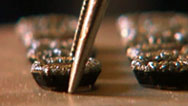Digital Diamonds?
- By David Levin
- Posted 04.01.09
- NOVA scienceNOW
Diamond has properties that make it ideal for creating transistors, those mainstays of many electrical devices. There's only one problem—no two natural diamonds are alike, and they need to be for mass production. Enter synthetic diamonds, which may play a significant role in electronics of the future.
Transcript
Digital Diamonds?
Posted: April 1, 2009
DAVID LEVIN: You're listening to a NOVA podcast. I'm David Levin. Over the last few decades, the speed of computer processors has grown dramatically. Today, even cell phones can out-perform desktops from the '80s. But there's a limit to how fast computer chips can get with existing materials. That's because hardware engineers are starting to run into a problem with silicon, the stuff that's used to make most commercial processors.
STEPHEN STEINER: One thing about silicon is that it fails when it gets hot. When a computer chip gets to about the boiling point of water, it starts to break down. It's not able to process information any more.
DAVID LEVIN: Stephen Steiner is a PhD student in materials science at MIT. He says part of the problem is that the faster computer chips get, the more heat they generate.
STEPHEN STEINER: And all of that heat being generated in turn prevents the silicon-based computer chip from being able to do its job. And so that limits the ability of material scientists and electrical engineers to keep making chips faster.
DAVID LEVIN: Steiner says that chip manufacturers have some tricks to get around this. But ultimately, he thinks it's time to move beyond silicon and find a new material to work with.
STEPHEN STEINER: Silicon is so twentieth century. Ultimately, we will have to change to a different platform, something that can withstand higher temperatures, something that can withstand higher frequencies.
â¦something you might not expect to see in electronics.
STEPHEN STEINER: and that material is Diamond.
DAVID LEVIN: The same stuff of engagement rings. Aside from just looking nice, diamond has electrical properties that make it attractive to engineers.
STEPHEN STEINER: One property about diamond that's really important is its thermal conductivity. It has the highest thermal conductivity of any material known. And when we push the limits of electronics in trying to get them to perform faster and carry higher voltages, that ability to withstand and carry heat away is very important.
DAVID LEVIN: It's also a great insulator. According to Steiner, a centimeter-thick diamond plate can withstand ten million volts. That's as much as a small lightning strike—something that would easily break down silicon and other materials.
And diamond has one more advantage. Under certain conditions, he says, it can be transformed into a type of material called a semiconductor. That's one of the main building blocks for computer chips.
STEPHEN STEINER: So, why are semiconductors important for computer chips? Well, one of the important things we can do with semiconductors is put them together to make what are called transistors. And so a transistor acts as a switch, allows us to controllably turn electricity on or turn electricity off, direct it the right way across the computer chip.
DAVID LEVIN: Steiner says that once we have diamond transistors, we'll be able to make a whole slew of new devices. There's just one catch: although this is possible in theory, it's not really feasible with diamonds that occur in nature.
JIM BUTLER: They're like snowflakes. Have you ever seen two snowflakes that are alike?
DAVID LEVIN: Jim Butler is a chemist at the Naval Research Laboratory in Washington, D.C.
JIM BUTLER: We've got billions of diamonds that we've mined out of the ground but trying to find two that have exactly the same properties is incredibly difficult.
DAVID LEVIN: To get around this problem, Butler is working on ways to grow diamonds consistently in a lab. He studies a process called Chemical Vapor Deposition, or CVD. It's a way to build diamonds atom by atom inside a vacuum chamber.
JIM BUTLER: CVD gives you flexibility, but it also gives you reproducibility and control. So we're really acting as the alchemists, you know, generating the material we want to make. Whereas in nature we have to search for billions of stones to find the two or three or ten that might have the properties we want. We can't control what nature's already grown.
DAVID LEVIN: While growing diamond this way seems promising for some applications, Butler says it may not be a panacea. It's much more expensive to make than silicon, and it's also harder to work with. The circuitry in a computer chip calls for a few different types of semiconductors, and some of them can't be easily made from diamond.
JIM BUTLER: Many of us talk about the potential of a new diamond age based on CVD diamond enabling all these new technologies, but how realistic is that? In my opinion, it's mixed. Diamond will find certain applications in electronics where it will perform better than silicon, but it won't be displacing everything else. It will be adding onto and enhancing what already exists. Silicon will always be around.
DAVID LEVIN: Despite these issues, though, Stephen Steiner is optimistic about the future of diamond. He's hoping that someday, it'll be as cheap and easy to manufacture as silicon.
STEPHEN STEINER: This is just the nascent stages of the ability to make diamond-based semi-conductors and diamond-based electronics. We do think of diamonds as an extravagance or a luxury oftentimes. But at one point, aluminum was an extravagance and a luxury. I believe it was Napoleon that had a very exclusive set of aluminum silverware at one point. And that's dirt cheap at IKEA now. (Laughs)
DAVID LEVIN: Don't expect diamond to be used in consumer devices any time soon. But Steiner and Butler both think that somewhere down the line, our electronics will have a little extra sparkle. For NOVA, I'm David Levin.
Credits
Audio
- Produced by:
- David Levin
- interview by:
- Julia Cort
Image
- (diamond disc)
- © WGBH Educational Foundation
Related Links
-

Diamond Factory
Visit a laboratory where entrepreneurs are growing perfectly pure diamonds.
-

Diamond Factory: Expert Q&A
James Butler of the U.S. Naval Research Laboratory answers questions about diamonds—natural and not.
-

Materials That Changed History
From ceramics to steel, paper to plastics, certain basic substances have long propped up civilization.
-

The World's Strongest Stuff
From diamonds to spider silk, see some of the hardest, strongest, and toughest materials on Earth.
You need the Flash Player plug-in to view this content.




